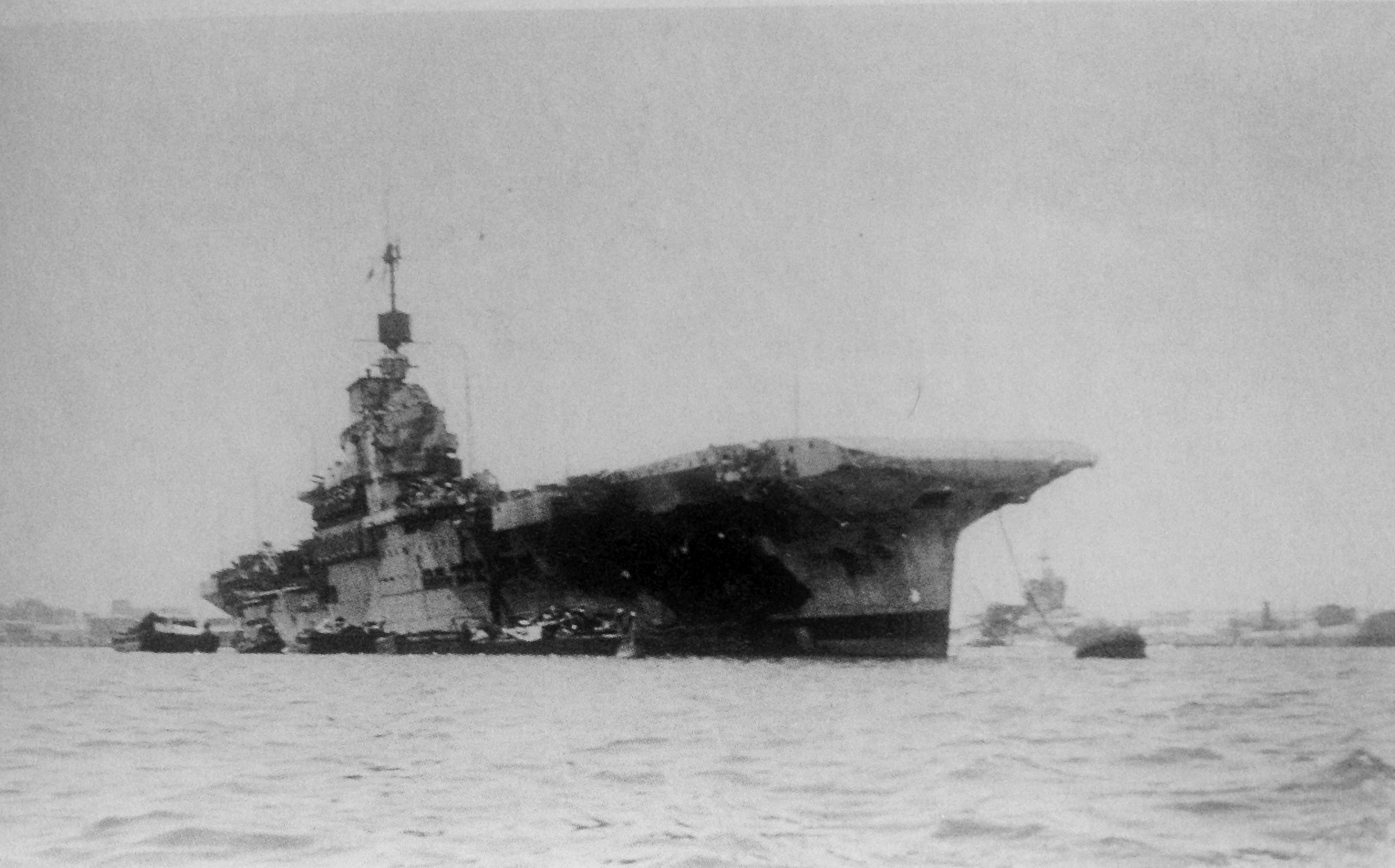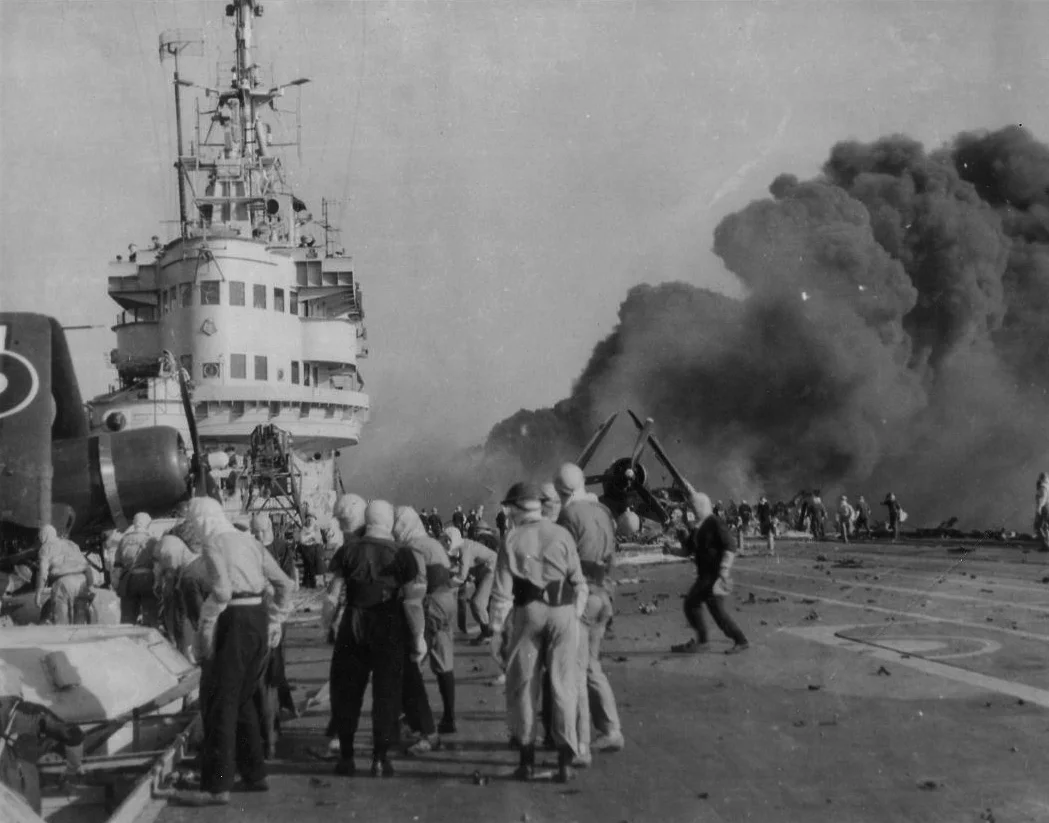“Bomb damage to HMS Formidable,
26 May 1941
H.M.S. FORMIDABLE, when operating in the Mediterranean on the 26th May, 1941, was attacked by JU. 87 dive bombers. Bombs, thought to be 1,000 Kgm. S.A.P. type, fuzed delay action, were released from about 500 feet in dive attacks. Two bombs made direct hits, one at 21.5 station, starboard side and the other abreast ‘X’. 1. (starboard) 5.25in mounting at 155 station. The vessel continued to steam at 18– 20 knots and to operate aircraft.”
Report by Director of Naval Construction
15 August 1942Bomb damage to HMS Formidable,
26 May 1941Bomb Hit No. 1
... This bomb pierced the Flight Deck (25 lbs.) at 21/ - station 10 ft. from the starboard side making a hole 21in diameter, perforated the Upper Gallery Deck (14 lbs. and beam 3.5 x 7in x 13.7lbs. T bar), glanced off the top edge of the starboard after bollard on the Lower Gallery Deck, perforated this deck (2.5in Borneo whitewood on 10 lbs. plate) and the Hangar Deck (14 lbs.) and exploded against 17 bulkhead between the Hangar and Upper Decks. The trajectory of the bomb before impact was forward and to port at about 25 degrees to the middle line and descending at 55 degrees to the horizontal. The distance of travel from point of first impact to point of burst was about 32– 35 ft. The detonation of the bomb was complete ...
Bomb Hit No. 2
... This bomb struck and perforated the top of ‘X’ Gun Bay, starboard, (12 lbs.) just outboard of ‘X’ 1 turret at about 155 station, grazed and dished the side of ‘X’ 1 turret revolving structure, perforated the deck of ‘X’ Gun Bay (12 lbs.) and the ship’s side (Sponson plating 14 lbs.) at the boundary of the Lower Gallery Deck in the Senior Officers Bathroom and burst below the water between 156– 157 stations about 18ft. from the ship’s side. The distance from point of first contact to point of burst was about 40 ft.
Hit No. 1 1000kg (2200lb)
The bomb which penetrated the forward flight deck about 10ft from the starboard side at 21.5 station left an entry hold of about 21inches diameter.
It had been dropped from 25 degrees to the forward centreline and plunged downward at a 55 degree angle.
The weapon passed through the 25lb Flight Deck, 14lb Upper Gallery Deck, 2.5in timber deck and 10lb plate on the Lower Gallery Deck, 14lb Hangar Deck and through to the 17 Bulkhead between the Hangar and Upper Decks.
The total distance travelled between impact and burst at No. 16 station was some 35ft.
Splinter holes were found up to 48ft from the estimated detonation point.
British and US Navy engineers judged it to have been a 1000kg (2200lb) Semi-Armour Piercing bomb.
Gaping wound ... the blackened void where the side of HMS Formidable was blown out in front and underneath of "A" 4.5in turret sponson is evident in this picture taken shortly after her return to Alexandria Harbour.
Forward section damage
The explosion of the 1000kg (2200lb) bomb forced outward Formidable’s starboard side plating between 11 and 24 bulkheads, extending from the Upper Deck and Lower Gallery Deck, and in parts down to almost Main Deck level. Large pieces of steel plate curled upwards and outwards.
The concussion had passed through the ship and blown out a portion of the port side plating at Hangar Deck level between 13 and 16 frames.
Major longitudinal frames between 11 and 24 bulkhead were destroyed on the starboard side on the Upper Deck and Lower Gallery Deck. Similar frames were destroyed between 12 and 21 stations on the Main and Upper Deck.
Several structural beams and T-bars were buckled and twisted under the Hangar Deck and Lower Gallery Deck. Stiffeners throughout the forward spaces were twisted, buckled and broken.
Bulkheads 11, 16 and 24 were holed and distorted, with watertight doors wrenched from their frames.
The damage tore apart the Paint Shop, crew’s toilets and Capstan Machinery compartment. The Stoker’s Upper Mess Deck had its deck dished, but the space was not penetrated.
The Decontamination Store had its bulkheads pierce and bulged, and the Paint Store was flooded. The Cable Locker Flat was partly flooded with distorted bulkheads, as were the Cable Lockers and Canvas Store.
The Hangar Deck’s FAA aircraft workshops and offices were completely wrecked by splinters. The watertight doors to the workshops were buckled and jammed.
Forward Lift: The blast distorted the forward side of the forward lift counter-weight trunks, buckling them inwards and bending the lift guides. The Hangar Deck beneath the lift was buckled upwards, preventing the lift platform from being lowered below 9inches above the deck level.
Accelerator: The structural distortion of the whole bow area extended to the assisted take-off mechanism. The single-track trolley guide and deck beneath the device had been distorted by upward dishing in the area of the windscreens.
Fire damage: A major fire ignited in the Aircraft Stripping Shop – most likely due to the paraffin used in the engine bathing tanks. Small fires started in most spaces, mostly in the woodwork.
All fires were quickly contained by damage control teams and extinguished within 15 minutes.
Flooding: The bulkhead at 37 station between the Main and Upper Decks was shored up by damage control teams as there was fears the Stoker’s Lower Mess Deck could become badly flooded. The largest hole in the starboard-forward corner of the mess deck was plugged with hammocks and shores.
The wrecked condition of the remaining forward sections prevented any efforts to drain flooded compartments until Formidable reached harbour.
Despite having her side blown out and severe structural damage forward, Formidable was able to maintain speeds of 18 to 20 knots in order to operate aircraft.
The weather was good and the sea calm. If the weather had been even slightly more severe, engineers estimated the waves would have fully flooded the forward spaces up to 37 bulkhead. and placed the weakened bow structure under increased strain.
As it was, the weakened structure was judged to be so severe as to only allow use of the forward lift and 4.5in gun groups in an emergency.
Opened to the elements ... part of the cavernous hole blown in the starboard forward side of HMS Formidable by a 1000kg (2200lb) bomb.
Armament: “A” and “B” group guns had continued to fire after the explosion occurred, their crews and mechanisms being largely unaffected by the blast and white-hot splinters. However, fire control cables from the Transmitting Station had been severed, as had control cables for pumps. The loss of power to “A1” turret put the mount out of action for a short time until emergency power leads were run from live lines. The forward ammunition conveyor belts continued to operate during the action but were judged unserviceable after reaching harbor because of weakened structural supports. The hoists between the Upper Deck to the Gun Bays were also temporarily affected by smoke and a loss of power.
Captain Bissett would report:
The damage control organisation worked well and it is satisfactory to note that all the armament with the exception of X. 1 turret which was jambed [sic], was in action very shortly after the ship was hit. ‘A’ group did particularly well under very trying conditions from the heat and smoke of the fire.
The detonation also had ripped away the degaussing cable and all electrical leads and voice-pipes forward of 24 bulkhead.
Hit No. 2, 1000kg (2200lb)
HMS Formidable’s War Damage Report asserts that this glancing-blow was also believed to have been from a 1000kg (2200lb) Semi Armour Piercing bomb.
No measurement of the initial deck penetration diameter was recorded in the formal report. However, a photograph of the hole in the bracket above the gun deck for X1 4.5in gun turret shows the extent of its size.
The bomb was believed to have been dropped from about 500ft in a dive-bombing attack.
It clipped the side of “X1” gun turret at 155 station, just outboard of the turret wall on the revolving mechanism.
The bomb passed through the 12.5lb gun embrasure, through the empty compartment beneath the 12.5lb gun house and out of the ship through the 14lb sponson – bursting under water some 40ft from the ship’s side adjacent 156 and 157 stations.
The bomb had travelled some 40ft after its fuze had been initiated.
The limited below-water blast damage from this bomb supports the argument that it was a SAP weapon. These generally have less near-miss effect than General Purpose or Blast variants.
HMS Formidable's crew look over a 4.5in gun turret during HMS Formidable's stay in Norfolk Naval Yards, United States.
German aircrew examine the tailplane "scorecard" of a Ju88 in March 1941, pictured two months before HMS Formidable was actually hit and two months after HMS Illustrious' ordeal.
AFT HIT DAMAGE
The dishing and buckling caused by the1000kg (2200lb) bomb’s passage through the ship prevented “X1” 4.5in turret from training. One 4.5in barrel was damaged and the fuse-setting machine wiring and other local wiring was severed. The turret was effectively out of action.
“X2” turret also was disabled for almost an hour. An electrical defect was located and repaired, bringing the turret back to full operation.
The underwater blast bulged the ship’s 30lb side plating between 148 and 163 stations, bursting some rivets and seams to initiate slow flooding. Several scuttles and deadlights were broken and the ship’s side plating pushed in up to the Lower Gallery Deck in the Senior Officer’s bathroom.
Flooding was contained to the Captain’s Store, Steering Gear Store, Palm compartment, Gland compartment and several watertight compartments.
Later it was discovered the starboard propeller’s “A” frame had been fractured at the boss.













